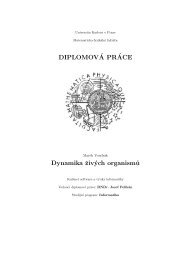Bachelor Thesis - Computer Graphics Group
Bachelor Thesis - Computer Graphics Group
Bachelor Thesis - Computer Graphics Group
Create successful ePaper yourself
Turn your PDF publications into a flip-book with our unique Google optimized e-Paper software.
6.3 D-Bus<br />
D-Bus [9] is a remote procedure call (RPC) and inter-process communication<br />
(IPC) mechanism. It was originally developed on Linux, to unify existing incompatible<br />
solutions. Windows port is under development. The specification<br />
itself is open, as well as the underlying technologies, such as a XML based interface<br />
description language (IDL). Binary message passing protocol promises<br />
low overhead and low latency.<br />
The goal of D-Bus is to allow applications:<br />
• communicate with each other within the same user’s login session (session<br />
channel), providing an efficient IPC mechanism<br />
• communicate with the operating system, system services and device<br />
drivers (system channel), applications can listen to various system-level<br />
events, such as printer status changes, connection of new hardware, etc.<br />
D-Bus is implemented in several layers. The main component is the central<br />
server - bus daemon, whose responsibility is to route messages between the<br />
sender and the receiver in the many-to-many paradigm. Direct peer-to-peer<br />
connections are possible too. Client applications are linked with libdbus.<br />
However, this low-level library is usually not used directly, but different programming<br />
languages and framework provide high-level wrappers. Applications<br />
provide services by exporting objects. Each object must have a globally unique<br />
name. Reverse domain path-like names are preferred. Qt provides D-Bus support<br />
in QtBus [30] module. It is fully integrated with QObject and signal/slot<br />
mechanism.<br />
D-Bus is a promising technology, which could potentially increase the possibilities<br />
of our applications. It would allow much more flexible invocation<br />
of user’s applications provided functions. These could even be launched on<br />
demand, if not running at the given moment. Although not yet used on Windows,<br />
the forthcoming release of KDE 4.1 applications for Windows should<br />
start the adoption of D-Bus on this platform. Plug-ins adding D-Bus support<br />
for existing extensible applications such as Firefox can be written. In case the<br />
application was ported to Linux, many Linux applications are already D-Bus<br />
enabled. Moreover, system-level commands, such as volume control, which<br />
does not have a common API generally, can be invoked easily.<br />
6.4 Miscellaneous<br />
As multi-core processors are becoming a standard in personal computers,<br />
multi-threaded programming is gaining importance. In our case, paralleliza-<br />
42
















